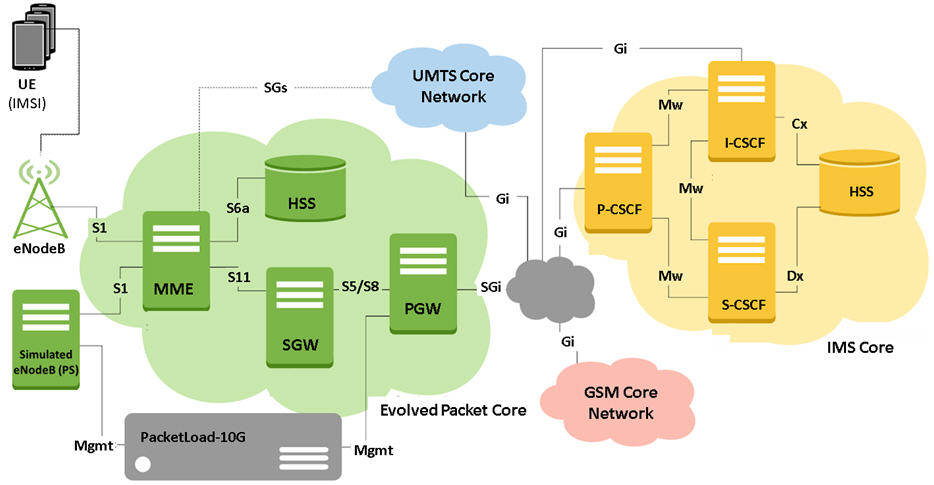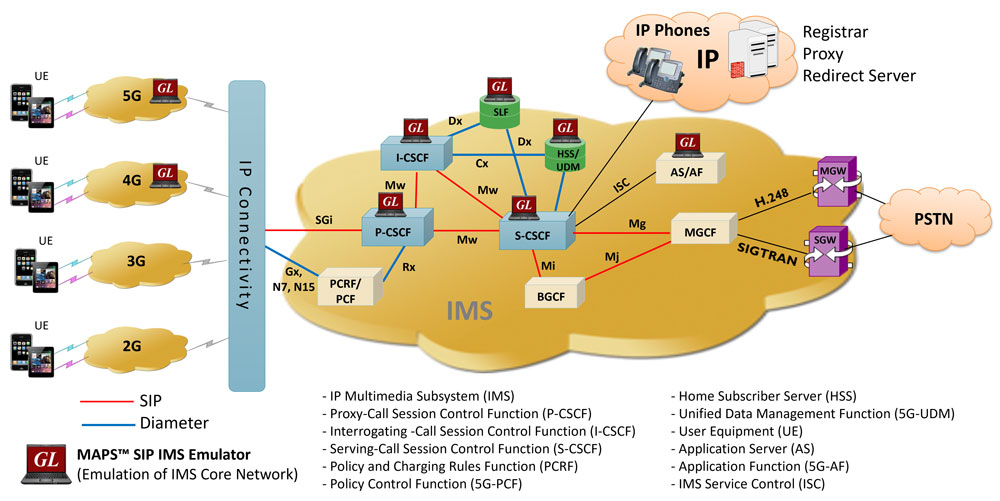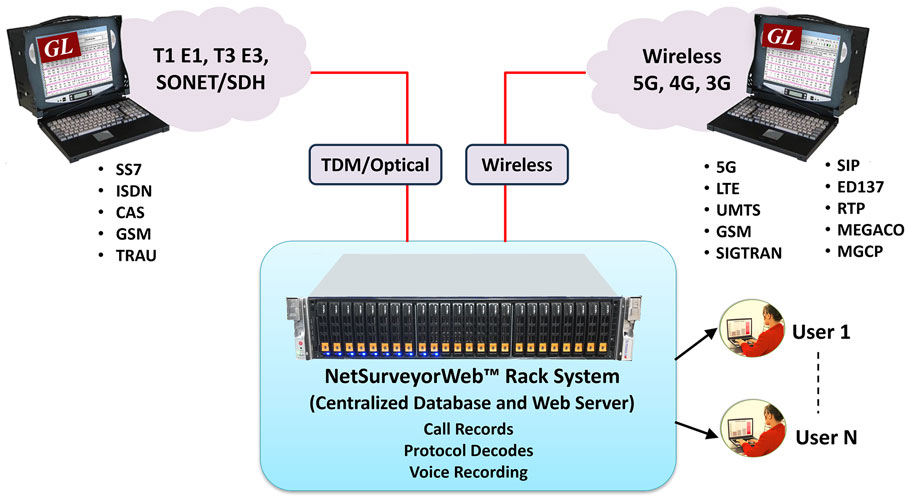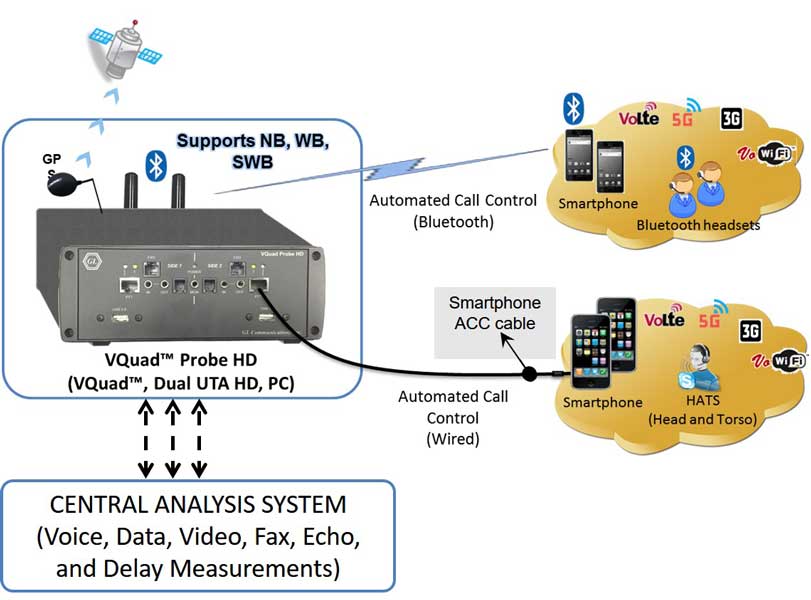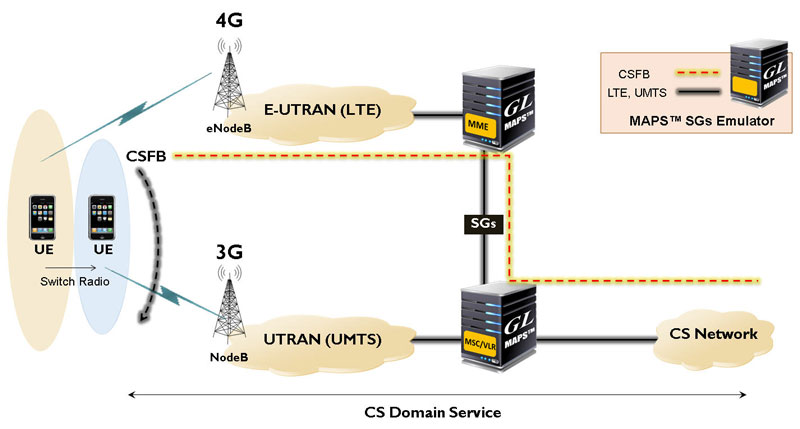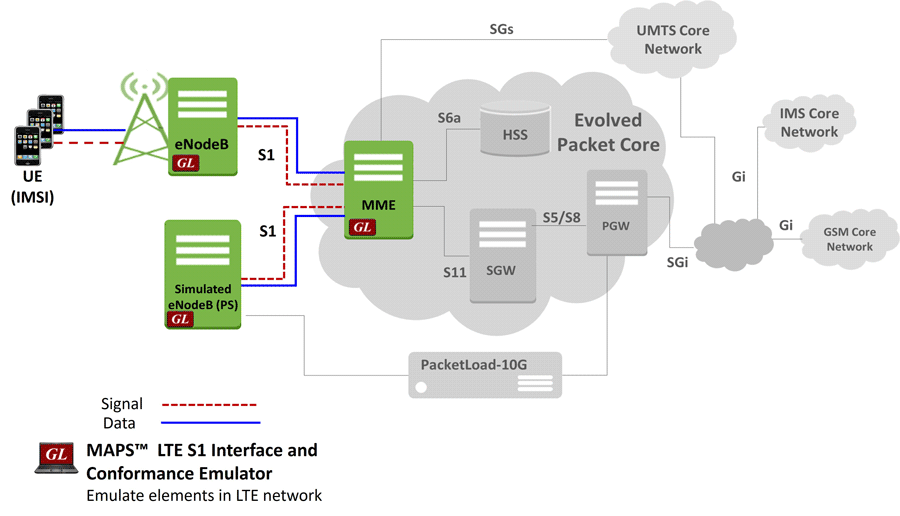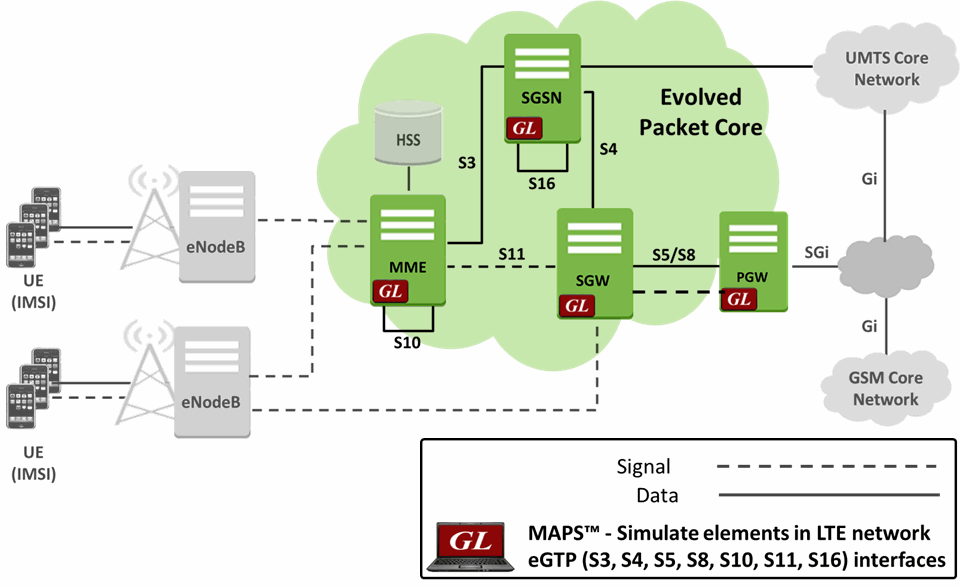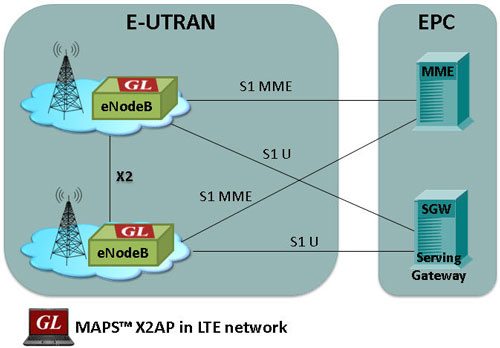LTE-IMS Network Test Solutions
Overview
Wireless networks are subject to interference from other networks, loss of signal strength over long distances, inclement weather, faulty or overloaded equipment and many other detrimental factors. This results in degraded voice and data quality. GL's LTE-IMS Analyzer provides a complete solution to monitor, emulate, and troubleshoot problems over LTE-IMS wireless networks.
GL's LTE-IMS Test Tool can capture, decode and perform various test measurements across various interfaces over LTE and IMS wireless networks. GL's Message Automation and Protocol Simulation Platform (MAPS™), a multi-protocol and multi-interface emulation software can be used to emulate almost all elements in the wireless 5G, and 4G VoLTE networks. Our latest High Density LTE Network Simulator can now generate a massive number of UEs (up to 500,000) along with high volume of mobile GTP and packet traffic to load test core LTE networks. One can also setup a virtual real-time network emulating all the network elements using ‘MAPS™ 2G 3G 4G 5G Wireless Lab Suite'.
What makes GL tools unique?
- Scripts and automation for emulation of wireless networks
- Unlimited ability to edit signaling messages, protocol fields, and call flows
- Flexible architecture independent of any protocol or network facilitating cross-domain testing
4G LTE Communications Network Lab
GL offers an End-to-End 4G LTE-IMS Network Simulation Test Suite (CNL) with all components such as eNodeB, MME, Serving Gateway, PDN Gateway, HSS, SGSN, PCRF, PCEF, AF and others to emulate both E-UTRAN and EPC (Evolved Packet Core), allowing complete testing of the LTE network.
All functionalities conform to industry standards. The CNL provides reliable integrated solutions to vendors and service providers for emulation, monitoring and troubleshooting wireless networks. Some of the real-time scenarios that can be understood with GL’s 4G LTE-IMS Lab solution are listed below:
- VoLTE calls using IMS, 4G user calling to 3G/2G user via CSFB
- High density packet traffic emulated using MAPS™ PacketLoad Server
- SMS sent from a roaming 3G UE to a roaming LTE UE
- CS fall back (CSFB) call from a roaming LTE UE and a roaming UMTS UE
- Generation of multiple UEs
- Mobile Traffic, web browsing and emulated UE web browsing Lab
- GTP mobile traffic supports generation and verification of data traffic such as Email, FTP, Web (HTTPS), video, and IP networks
- Interfaces Supported:
- LTE interfaces S1, S3, S4, S5/S8, S10, S11, S16, X2, eGTP, SGs
- Diameter interfaces -S6a, S6d, S13, Cx/Dx, Gx, Rx , Gy/Ro, Gm, Sh, & SGi
- Location Services - SLs, SLg, SLh
- IMS Interfaces - Mw, Mi, Mj, Mg, ISC
Emulation of IMS Interfaces
MAPS™ IMS (IP Multimedia Services) emulates multiple UEs and IMS core elements using SIP (Session Initiation Protocol) to package voice, video, data, fixed, and mobile services on a single platform to users. The application emulates IMS network core entities such as P-CSCF, I-CSCF, S-CSCF, PCRF, MGCF and IP-SM-GW to test multiple interfaces in the IMS core network such as - Cx/Dx, Rx, Gx, Gm, Mw, SGi, Mi, and Mj. With the help of real mobile phones, and other emulated elements, the application allows for making real-time VoLTE calls and also interworking of LTE network testing as well as- IMS network testing with PSTN and VoIP networks.
IMS Protocol Analyzer within PacketScan™- All IP Protocol Analyzer is capable of real-time capturing, decoding and analyzing SIP signaling and RTP media for live systems as well as the Diameter signaling used for accessing subscriber data and charging data on IMS networks.
PacketScan™ permits continuous monitoring of communication over IMS - S6a, S6d, S13, Cx/Dx, Gx, Rx, Sh, Gy/Ro interfaces. Other interfaces such as Rf, Dh, Gq, Zh, Zn, Wa, Wd, Wx, Wm, Wg, Pr will also be supported by the application in near future.
Following test scenarios can be performed using MAPS LTE and IMS simulators :
- UE Non-Roaming Registration
- Voice Call between Non-Roaming Users on the same network
- Voice Call between Non-Roaming User to Non-Roaming User on different networks
- Voice Call from IMS to PSTN Network
- UE Roaming Registration
- SMS call over LTE network
- SMS Service between roaming 4G to 2G/3G network
- Voice calls through IMS Network between 4G and 3G users
- Use of CAMEL for SMS and Prepaid Calls
- Streaming Online Video from a Roaming 3G/4G UE
- End-to-End online and offline charging emulation
Centralized Web-based LTE Monitoring System
GL's NetSurveyorWeb™ is based on a scalable and flexible architecture. It is used in conjunction with GL's LTE Protocol Analyzer and IMS Protocol Analyzer probes to non-intrusively monitor the entire network from a central remote testing location.
LTE-IMS Analyzers have unlimited ability to facilitate real-time analysis, historical storage, retrieval, querying, and display of Call Detail Records (CDRs). The analyzers support almost all LTE-Diameter-IMS protocol stack for decoding, such as S1, S3, S4, S5 (or S8), S10, S11, and X2 interfaces and Diameter sessions over S6a, S6d, S13, Cx, Dx, Sh, Gx, Rx and Gy/Ro interfaces.
GL's LTE-IMS protocol analysis probes feed data to centralized database (Oracle) in real-time for further analysis. These probes capture, decode, and segregate the traffic to calls and forwards the CDRs, signaling frame details, and other statistics to the centralized database server. The central system comprises of a database engine, web server, and NetSurveyorWeb™, a web-based application, to facilitate data storage and retrieval through web browser clients. It can process large volumes of real-time and historical data, filter for specific calls, build custom statistics and KPIs and provides automation and graphical features to analyze the CDRs.
LTE/5G QoS Test Suite for Voice, Video, & Data Quality Testing
VQuad™ Probe HD is a self-contained network testing tool used to evaluate Signal Strength, Voice, Video, & Data Quality on Cellular networks (5G, 4G VoLTE, 3G, 2G), Land Mobile Radios, and Wired networks.
It includes VQuad™ software, Dual Universal Telephone Adapter (Dual UTA HD), and PC in a portable platform. VQuad™ Probe HD can connect to practically any endpoint, wired or wireless devices, independent of underlying network type. VoLTE testing supported using either Bluetooth® or wired headset connection methods.
Various associated analytical applications (Voice Quality, Video Quality, Data tests, Echo and Delay tests, Fax tests, Voice Band Analysis) work with the base VQuad™ software to provide an end-to-end assessment of the network performance.
GL’s Voice Quality Testing (VQT) supports automated voice quality between using - POLQA (ITU-P.863) and PESQ (ITU-P.862). The POLQA algorithm is specifically used in wideband VoLTE network testing.
GL’s VQuad™ NetTest solution supports egress/ingress Data analysis along with Voice/Video Quality Testing and GPS.
Massive LTE UE and Traffic Emulation
GL’s MAPS™ Server with PacketLoad appliance supports massive emulation of UEs (up to 500,000) along with high volume of mobile GTP-C (control plane), GTP-U (user plane) and packet traffic for up to 4 Gbps or 40 Gbps to load test or stress test core LTE networks.
It offers all features to perform functional unit tests at every integration point within the wireless infrastructure. The MAPS™ Server with PacketLoad™ can be used to test all network elements in access & packet core to ensure negotiated QoS is met.
The solution encapsulates the generated packet data within GTP headers and transmit through the gateway points such as SGSN & GGSN, or SGW & PGW. It allows simultaneous emulation of multiple sessions per user to verify bearer allocation bandwidth at the end points. Currently, the solution offers stateful TCP/HTTP, and PCAP Replay traffic types. PacketLoad supports HTTP traffic emulation with the base requirements such as port number, server IP address, and pre-canned HTTP traffic file.
Emulation of SMS and CS Fallback
With CSFB (Circuit-switched Fall Back) feature, an LTE device "falls back" to the 3G or 2G network to complete the call or to deliver Voice and SMS.
GL’s MAPS™ SGs is designed to emulate the CS fallback function for Voice and SMS delivery via the Circuit Switched (CS) core network using SGs interface between the MME in the EPS and the VLR, as per 3GPP specifications. The SGs Application Part (SGsAP) protocol used on the SGs interface between the MME <-> MSC/VLR allows location management co-ordination and relay certain messages related to GSM circuit switched services over the EPS system.
In addition, MAPS™ IMS emulators can emulate functions of an IP-SM-GW network element in order to push or pull SMS from LTE-EPC to SMSC over IP/IMS network. In SMS over IMS communication, SMS is encapsulated in a SIP message and carried over IMS core network to SMSC. The IP Short Messaging Gateway (IP-SM-GW) network element provides the interconnection between GSM-UMTS network and LTE-EPC network for sending and receiving SMSs.
Emulation of LTE S1 Interface
GL's MAPS™ designed for testing LTE - S1 interface can emulate Evolved Node B (eNodeB), and Mobility Management Entity (MME) network elements. The application gives the users unlimited ability to edit S1-AP/NAS messages and call scenarios (message sequences).
The product supports real-time GTP traffic using Mobile traffic core - GTP between any two nodes in LTE and UMTS networks.It also supports Mobile Traffic Core - Gateway module to offload GTP traffic to media gateway over IP. These modules also support generation and verification of data traffic such as Web (HTTP).
Emulation of LTE eGTP Interfaces (S3, S4, S5, S8, S10, S11 and S16)
GL's MAPS™ designed for LTE network testing for eGTP interfaces such as S3, S4, S5/S8, S10, S11, & S16 which can emulate Mobility Management Entity (MME), Serving Gateway (SGW), and Packet Data Network Gateway (PGW) network elements. The MAPS™ LTE eGTP supports emulation of Path Management procedures, Tunnel Management procedures, Control Plane, and User-plane GTP traffic emulation over eGTP interfaces.
The product supports real-time GTP traffic using Mobile traffic core - GTP between any two nodes in LTE and UMTS networks. It also supports Mobile Traffic Core - Gateway module to offload GTP traffic to media gateway over IP. These modules also support generation and verification of data traffic such as Web (HTTP).
Emulation of LTE X2 AP Interface
The X2 Application Protocol (AP) is the interconnecting interface between two eNodeBs in LTE network and supports both Control Plane and User Plane. GL's MAPS™ LTE X2AP is used to co-ordinate handovers and perform load management between eNodeBs - Source eNodeB and Target eNodeB. The MAPS™ X2-AP test tool is designed with specific test cases, as per LTE 3GPP TS 36423-900 standards.
LTE X2 AP emulates thousands of UEs and supports Mobility Management, Load Management, Error Situations, Re-setting X2, Setting up the X2, and eNodeB Configuration Update procedures.
